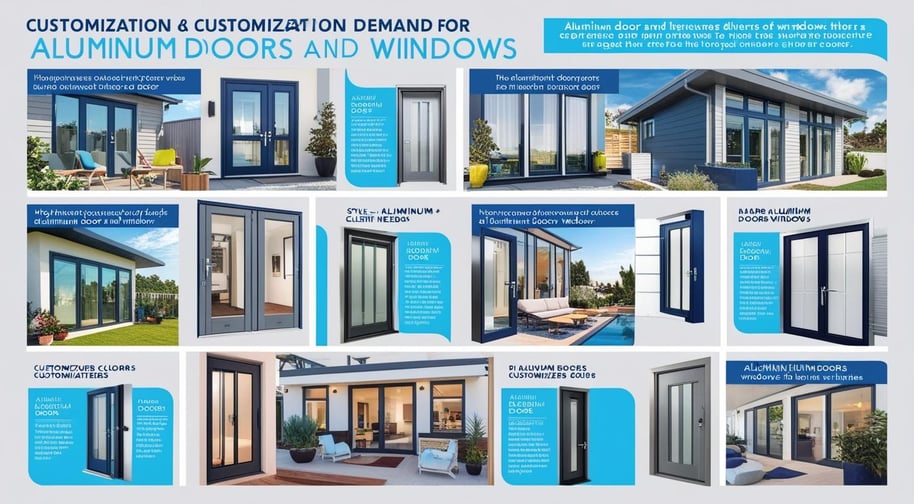Customization Demand for Aluminum Doors and Windows: How to Meet Unique Client Needs?
4/18/20255 min read


Understanding Customization in Aluminum Doors and Windows
Customization in aluminum doors and windows refers to the process of tailoring various elements to meet specific client preferences and requirements. This versatility allows for adjustments in multiple aspects, including size, color, finish, hardware options, and overall design styles. As the construction and renovation sectors evolve, the demand for bespoke solutions is increasing, emphasizing the importance of meeting individual client needs.
One of the primary facets of customization is size. Aluminum doors and windows can be manufactured in different dimensions to accommodate various architectural styles and structural requirements. This flexibility ensures that clients receive products that fit seamlessly into their existing spaces, enhancing functionality and aesthetics. Additionally, discerning homeowners and builders often seek personalized color options that align with their design vision. Custom powder coating processes allow for an extensive palette, enabling clients to choose shades that harmonize their outdoor and indoor environments while maintaining the aluminum's integrity.
Another aspect of customization includes finishes. Beyond standard options, various textures and coatings can be applied, such as matte, glossy, or textured finishes, which add to the product's visual appeal. Furthermore, hardware choices, including unique handles, locks, and hinges, can significantly impact both the functionality and overall look of aluminum doors and windows. Clients are increasingly leaning towards distinctive hardware options that reflect their personal style and complement their architectural elements.
Design styles are also integral to the customization process. Aluminum doors and windows can be designed to reflect modern, traditional, or eclectic aesthetics, allowing clients to achieve their desired ambience. This growing trend of customization in aluminum products highlights the necessity for businesses to adapt and provide solutions tailored to individual preferences. By catering to the unique requirements of clients, manufacturers enhance customer satisfaction and foster loyalty, establishing lasting relationships in an increasingly competitive market.
Identifying Client Needs and Preferences
Understanding the unique needs and preferences of clients is crucial when it comes to aluminum doors and windows customization. To effectively identify these requirements, a structured approach can be adopted, beginning with the utilization of various methods for gathering client feedback. Surveys are a powerful tool for collecting initial data, allowing clients to express their preferences in a systematic way. By crafting targeted questions, manufacturers can gain insights into clients' specific desires regarding aesthetics, functionality, and features.
In addition to surveys, consultations play a vital role in the identification process. Scheduled meetings provide a direct channel for communication, whereby clients can discuss their visions for aluminum doors and windows in detail. During these consultations, professionals should emphasize active listening to ensure that every concern is acknowledged and addressed. This interaction fosters a collaborative atmosphere that can lead to better outcomes, as clients feel more invested in the customization process.
Interactive design tools have emerged as another innovative method for engaging clients in the decision-making process. These tools often allow clients to visualize how different styles, colors, and configurations will look in their own space, which can be instrumental in aligning their expectations with practical options. Through these platforms, clients can experiment with various designs, making it easier for them to convey their preferences accurately to manufacturers.
A thorough understanding of a client's lifestyle, architectural style, and functional needs is essential in tailoring aluminum doors and windows to their specifications. Engaging in dialogue regarding how they intend to use the space can help identify additional requirements, such as security features or energy efficiency. By ensuring clear communication and a comprehensive understanding of each client's aspirations, manufacturers can create customized products that truly embody their vision.
Tailoring Solutions to Meet Client Demands
The demand for aluminum doors and windows is continuously evolving, prompting manufacturers to adopt flexible strategies that cater to the unique needs of each client. One of the most effective approaches to tailor solutions is through the implementation of flexible manufacturing processes. This allows manufacturers to adjust production lines and create variants that satisfy specific customer requirements without significantly increasing lead times or costs. By adopting modular designs, companies can make adjustments in dimensions, colors, and styles, ensuring that the final products align with the client's vision.
Moreover, offering a diverse range of options is paramount in accommodating customer preferences. Suppliers should facilitate clients’ access to different finishes, handles, and glazing types. By providing extensive customization options, manufacturers can help clients visualize the final product better, which in turn aids in the decision-making process. For instance, a client may want an aluminum window with a unique matte finish rather than the standard gloss, or perhaps a specific type of insulation for better energy efficiency. Such attention to detail enhances customer satisfaction and can distinguish a company from its competitors.
Collaboration with clients is essential in the customization process. Engaging clients early in the design phase allows manufacturers to grasp the nuances of their requirements. Regular consultations and feedback mechanisms can lead to the development of tailored solutions that meet or exceed expectations. A notable example is a manufacturer who worked closely with an architect on a residential project, leading to the creation of a series of bespoke aluminum doors that not only met aesthetic criteria but also improved thermal performance. This case exemplifies how collaborative efforts can enhance the product development process and result in successful customizations. Through such strategies, the aluminum doors and windows industry can effectively cater to the increasing demand for personalized solutions.
Streamlining the Customization Process for Efficiency
In responding to the increasing demand for customized aluminum doors and windows, streamlining the customization process becomes essential to ensure efficient delivery and maintain high-quality standards. Several methods can be employed to achieve this, beginning with the integration of advanced technology such as Computer-Aided Design (CAD) and 3D modeling tools. These technologies allow designers and manufacturers to visualize custom concepts more clearly, reducing errors and ensuring that the final product aligns with the client’s expectations. This precision not only enhances the creative process but also expedites the overall customization time frame.
Moreover, optimizing supply chain management plays a critical role in ensuring that materials required for custom projects are readily available. By establishing strong relationships with suppliers and defining clear logistics processes, organizations can enhance responsiveness to unique client requests. Adopting Just-In-Time (JIT) delivery systems may further optimize inventory levels and reduce the lead time associated with custom projects, thus providing significant flexibility in meeting varying client demands. Additionally, utilizing data analytics can guide decision-making in sourcing materials based on historical trends and anticipated demand, streamlining the entire supply chain process.
Furthermore, training staff to efficiently handle unique requests is vital in maintaining quality assurance while adapting to custom orders. Cross-training employees across different facets of production can enhance their understanding of the entire manufacturing process, empowering them to tackle challenges associated with customization effectively. Establishing clear communication channels within teams ensures that everyone is aligned with project specifications, timelines, and client expectations.
The balance between catering to custom requests and adhering to production timelines presents a challenge; however, implementing best practices can mitigate risks. By prioritizing customization projects according to their complexity and anticipated timelines, companies can effectively manage resources while keeping customer satisfaction at the forefront of their operational strategies.
